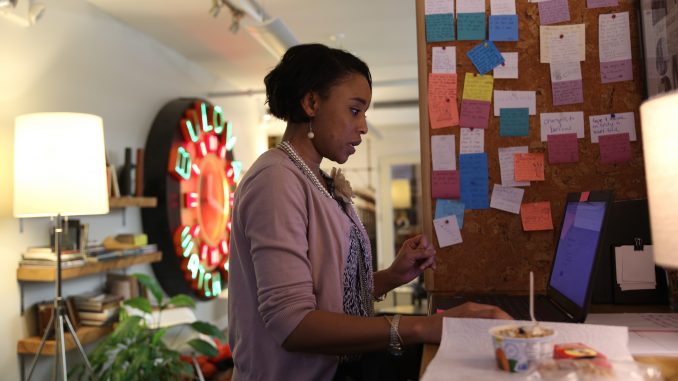
More than a decade ago, Erica Hawthorne-Manon headed into a coffeehouse in search of a comfortable study spot. Instead, she encountered lush velvet sofas, deep conversation, African-American murals and the drifting sound of local music.
Hawthorne-Manon, a 2005 master’s of African American studies alumna, said the coffee shop, called Crimson Moon, was a haven that first exposed her to Philadelphia’s pulsating art scene.
“It was a coffee shop, but it was a hub,” Hawthorne-Manon said about the cafe at 20th and Sansom streets. “Like, you could literally come from anywhere and visit Philly and say, ‘you know, I want to find out where the open mics are.’”
Now, Hawthorne-Manon not only actively follows Philadelphia’s art, but she also nurtures it. Since 2012, her nonprofit organization Small But Mighty Arts has provided local artists — from photographers to fashion designers — with some of the resources they need.
SBMA endows artists with grants in amounts between $150 and $1,000. While smaller than a typical grant, the money is transferred to the artist sooner than many other grants, about two months after the application deadline.
For Pamela Hetherington, a professional tap dancer who owns the company Take It Away Dance, those funds arrived at the perfect time. Hetherington, who organizes free community dance classes, was searching for financial support when she received a congratulatory call from SBMA.
“I just, like, dropped the phone,” Hetherington said. “I just didn’t think anybody cared about tap, you know, or like, what I was doing.”
Filmmaker Brittany Rafalak needed similar resources while working on a graduate thesis at the New School in New York City. She commuted to New York City from Philadelphia, looking to find an audition space for her film. The accessibility of the grant encouraged Rafalak to apply.
“When there’s really big grants, it’s a lesser chance of getting it because everybody wants it,” Rafalak said.
She went on to put the grant toward “Consumption,” her fiction film about food and society.
“Artists are just trying to figure out how to expand their audience beyond just the people, your friends and family and if we can support them in doing that, all the better,” Hawthorne-Manon said.
As a writer and actress, she is familiar with the struggles of making projects come to fruition.
Hawthorne-Manon, a Kansas City, Kansas native, moved to Minneapolis in 2001 and discovered spoken-word poetry. Craving a city with a faster pace, Hawthorne-Manon left the Midwest to pursue a master’s degree in Philadelphia in 2003. Soon after arriving here, she embedded herself into the art community and fell into rhythm with life on the East Coast.
“You can come here and you can make and you can create what you want,” she said. “And that’s what Philadelphia and my time at Temple represented for me.”
She began performing in open mics for the October Gallery in Germantown, which showcased African-American art, and Black Lily, a women’s arts initiative that often hosted performances at World Cafe Live.
Inspired by Philadelphia’s music scene, Hawthorne-Manon released “Spoke Inward” — a spoken-word album — in 2006. While a solo album, the work features local artists and musicians Hawthorne-Manon met along the way.
“There were times in the studio where I needed background vocalists and there were, like, three of my poetry colleagues or friends, and we were making it happen,” Hawthorne-Manon said. “But that’s how it happens here.”
She went on to co-found Spoken Soul 215, an initially small artists’ collective that now hosts Harvest Open Mic, one of the city’s largest performances of its kind, at World Cafe Live.
Hawthorne-Manon said the longer she stayed in Philadelphia, the more she noticed a city in artistic flux.
“I joke and say I came at the time of the party, that stage where the party was kind of transitioning and ending,” she said.
The coffee shop that had once enraptured Hawthorne eventually closed down. The October Gallery moved out of its Old City location. While Black Lily continues as an arts organization today, the venue that once hosted its shows — the Five Spot — shut down after a fire in 2007.
But with those endings, Hawthorne-Manon noticed new beginnings — the “emerging, up-and-coming” artists, she said, who are keeping Philadelphia creative.
“I’m really hopeful about where [the scene is] going … what’s happening and the kind of work that creatives in Philadelphia are doing,” she said.
While she had never organized a nonprofit before, Hawthorne-Manon said a combination of persistence, creativity and partnerships helped SBMA materialize. A grant from the Knight Foundation and a partnership with CultureWorks also helped.
“For every program and every project, I feel like I’m creating something,” Hawthorne-Manon said.
For Hetherington, SBMA’s grant propelled her forward into bigger projects. While her professional company performs at landmarks like City Hall and the Reading Terminal Market, her community classes now receive funding from the city and the state, making tap dance accessible to those who can’t afford classes.
Hawthorne-Manon and her mission, Hetherington said, have helped fuel live arts like hers in Philadelphia.
“She’s part of the reason that the art scene is so vibrant, I truly believe [in] the last few years,” Hetherington said. “She’s just the forefront.”
Angela Gervasi can be reached at angela.gervasi@temple.edu or on Twitter @AngGervasi.


Be the first to comment